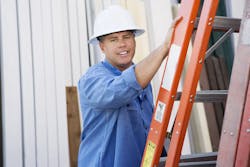If your focus is on avoiding OSHA citations, then avoiding citations is what you’ll do. You’ll figure out what you can get by with, but you won’t necessarily prevent John from falling and breaking his back. Compliance avoids fines; assurance avoids injuries.
Here’s an example to illustrate the difference between compliance and assurance. Your company does a lot of ladder work on tile floors. The tile is smooth. You believe you satisfy OSHA by instructing electricians to use a ladder at the correct angle. Here are some other ways you can you protect your workers:
- Use strips of friction tape to create a non-skid ladder surface.
- Buy ladders with nonskid feet, and retrofit or replace existing ladders as needed.
- Use stabilizer bars with extension ladders.
- Use automotive wheel chocks or “rubber” door stoops to block ladder feet from skidding.
- Equip each crew with a roll-up surface, such as a 4 × 4 nonskid mat, on which to place a ladder, or use standard ladder mats made for this purpose.
- Equip each crew with 4 × 4 rock climber “crash pads” to reduce chance of injury.
You can combine these as conditions merit, and crews can do such things as:
- Lay another ladder on the ground to “connect” the first ladder to a nearby wall so the ladder bottom can’t move (push strategy).
- Tie the ladder so it can’t slide away (pull strategy).
- Have a helper stand against the ladder feet to keep them from moving.
- Park a lift truck or other heavy item at the base of the ladder, so there’s no room for it to slide.
OSHA doesn’t require you to do these things, so you could skip them and still check the box that you comply. However, going into a mindset of identifying and eliminating hazards is how you move all safety, including ladder safety, from compliance to assurance.
Can’t meet OSHA?
What if your company is stuck in a mode of struggling to meet OSHA regulations? Use the assurance mindset to win that battle.
For example, suppose that last year OSHA cited your company several times for ladder safety issues. How do you prevent more of those same citations? First, list the citations. Then go through each one and ask each involved worker to suggest how to eliminate the cause.
Using the Five Questions method can help. For example, an OSHA inspector caught Eric standing on the top rung.
- Why was Eric doing that? Because he did not have a tall enough ladder.
- Why didn’t he have a tall enough ladder? Because all the tall enough ladders were in use by other people, which means they lacked sufficient tall enough ladders.
- Why were there insufficient tall enough ladders? Because the company buys X number of ladders of each height, and that’s it.
- Why does the company buy only so many ladders of each height, and why those particular heights and numbers? Because nobody bothered to examine actual ladder use in the field.
- What lengths of ladders are actually needed in the field, and how many of each length will prevent a shortage?
Let’s say you come up with numbers for that last question. You price those ladders. Oops. Where is that money going to come from? The answer is to go back to your basic assumptions about ladders. Were you thinking you need X stepladders of Y length? Were you also thinking those must be a fixed length? Question: Are your extension ladders of fixed length? No, they are adjustable. Therefore, buy adjustable stepladders to cover a range of lengths. Now that price tag is much smaller.
Every year, OSHA releases a report showing how many citations there were in each category of safety. Unfortunately, ladder safety continues to be in the top 10 each year. In fact, it was number six last year. Fall protection was number one, scaffolding was number three, and fall protection training requirements were number nine. Notice how these are all related to gravity. Ladder safety was number six in 2018 and 2017. It was number seven in 2016 and 2015, and number eight in 2014. Falling down has been moving up.
Let’s look at a few OSHA requirements [1926.1053]:
- “A self-supporting portable ladder must be able to support at least four times the maximum intended load.” The higher the load rating of a ladder, the more it costs. This is an incentive for choosing a lower-rated ladder. However, people tend to weigh more these days, and you can’t leave out items like tools, parts, and equipment that will be supported by the person on the ladder.
- Several requirements can be summed up as “no slipping on the rungs.” Your first defense is to buy only ladders with specific features to satisfy these requirements.
- “Ladders shall be used only on stable and level surfaces unless secured to prevent accidental displacement.” Notice the language, here. It doesn’t say, “Unless some additional measure is taken to reduce chances of a slip.” The word “prevent” is used. If you’re setting the ladder on gravel, you can reduce the chances of slip by mashing the gravel down with your foot. Or you can prevent a slip by setting a sheet of plywood on top of the gravel and securing it. Similar thinking goes into accommodating a slippery surface.
- “Ladders shall be inspected by a competent person for visible defects on a periodic basis and after any occurrence that could affect their safe use.” This does not say, “If you notice a siderail crack, be careful using that ladder.” It means there must be a deliberate, methodical inspection of each ladder on a regular schedule and after any time the ladder might have been damaged. The implication is any ladder failing such an inspection is taken out of service because other language in 1926.1053 makes it clear the ladder must be safe to use.
If you want to ensure OSHA compliance as a baseline for ladder safety in your organization, then:
- Assign a few people (not all of them supervisors) to be “OSHA inspectors” for ladder safety and provide them the training they need to do that job.
- Give them tags to put on unsafe ladders and let them “write up” people for unsafe ladder use. Each write-up should ask, “How could you have done this more safely?” and include the answer from the person who was written up. Formal discipline is not used in this process; it’s a self-awareness exercise.
- Rotate people through this “inspector” position quarterly so everyone takes a turn at it.
- If the process reveals any issues the company must resolve (e.g., lack of equipment), those should be identified to management for resolution.
Beyond mere compliance
We started off with the idea that OSHA compliance should not be your focus. If your focus is on preventing ladder-related injuries, OSHA regulations serve as a helpful starting point toward that end — not as an end in itself.
In some organizations, there is resistance to this idea because people believe going beyond OSHA means extra cost and extra responsibility. Yet when you settle for mere compliance, it’s human nature to not quite get there. Look again at how many times ladder safety violations are among the top 10 OSHA violations despite being easy to eliminate.
Begin by examining and questioning any equipment, tasks, and procedures that involve elevation and thus gravity — not just ladders, but fall protection, fall arrest, and falling objects. All these are related, so you don’t want to address any of them in isolation. How might gravity pose a danger to someone engaged in the kind of work done by your company?
How do people get tools and materials to elevation? If they carry these things up the ladder (an unsafe practice), what alternatives could you provide? Are alternatives ad hoc (e.g., tie a rope to the drill) or planned (e.g., clip a carabiner onto the loop that’s affixed to the drill)? Would any alternatives lead a person to reach or lean in an unsafe way?
Related to this, how are tools and materials prevented from falling? If tools and materials fall, will they cause damage or injury absent certain precautions? Which precautions are those? Solutions to falling objects include carabiners, buckets, barrier strips, tie-offs, and nets. Which solutions address your particular problems?
There’s no mystery to ladder safety, except for those who practice “comply to get by.” Those who make safety the goal will have no problem finding answers to ladder safety questions — nor will they have a problem asking the right questions in the first place.
Lamendola is an electrical consultant located in Merriam, Kan. He can be reached at [email protected].
About the Author

Mark Lamendola
Mark is an expert in maintenance management, having racked up an impressive track record during his time working in the field. He also has extensive knowledge of, and practical expertise with, the National Electrical Code (NEC). Through his consulting business, he provides articles and training materials on electrical topics, specializing in making difficult subjects easy to understand and focusing on the practical aspects of electrical work.
Prior to starting his own business, Mark served as the Technical Editor on EC&M for six years, worked three years in nuclear maintenance, six years as a contract project engineer/project manager, three years as a systems engineer, and three years in plant maintenance management.
Mark earned an AAS degree from Rock Valley College, a BSEET from Columbia Pacific University, and an MBA from Lake Erie College. He’s also completed several related certifications over the years and even was formerly licensed as a Master Electrician. He is a Senior Member of the IEEE and past Chairman of the Kansas City Chapters of both the IEEE and the IEEE Computer Society. Mark also served as the program director for, a board member of, and webmaster of, the Midwest Chapter of the 7x24 Exchange. He has also held memberships with the following organizations: NETA, NFPA, International Association of Webmasters, and Institute of Certified Professional Managers.
